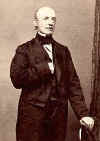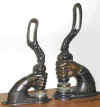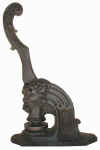Early Office Museum
~ Antique Seal Press Gallery ~
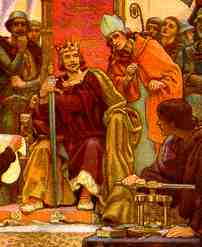 Wax seals have been applied to official and other documents for over
a thousand years. The seal-die that is pressed into the sealing wax is
called a matrix. Modern discussions of medieval wax seals make references
to seal presses. For example, "If it was a two-sided seal,...the two
sides of the seal matched exactly and could be pressed together either by force
of hand or a seal-press." ("Declaration of Arbroath," Society of
Archivists) "The matrices could range from a small stamp, as on a
signet ring, to a double sided mould operated in a press, necessary to produce
such monumental objects as the great seal of England." The source of the
last statement, Medieval Writing,
presents the image reproduced to the right with the caption "A schoolbook image of
the great seal press. Bad King John [reign 1199-1216] in the background,
of course. A similar seal press to this, mounted on a hefty oak block,
survives in the library of Canterbury Cathedral." (Note: Large screw
presses somewhat similar in design to the one in the picture to the right have been
used to manufacture coins and medallions. Such screw presses are on display at
the National Museum of American History, Smithsonian Institution, Washington,
D.C.)
Wax seals have been applied to official and other documents for over
a thousand years. The seal-die that is pressed into the sealing wax is
called a matrix. Modern discussions of medieval wax seals make references
to seal presses. For example, "If it was a two-sided seal,...the two
sides of the seal matched exactly and could be pressed together either by force
of hand or a seal-press." ("Declaration of Arbroath," Society of
Archivists) "The matrices could range from a small stamp, as on a
signet ring, to a double sided mould operated in a press, necessary to produce
such monumental objects as the great seal of England." The source of the
last statement, Medieval Writing,
presents the image reproduced to the right with the caption "A schoolbook image of
the great seal press. Bad King John [reign 1199-1216] in the background,
of course. A similar seal press to this, mounted on a hefty oak block,
survives in the library of Canterbury Cathedral." (Note: Large screw
presses somewhat similar in design to the one in the picture to the right have been
used to manufacture coins and medallions. Such screw presses are on display at
the National Museum of American History, Smithsonian Institution, Washington,
D.C.)
 The earliest seal press designed (apparently) to emboss a seal onto paper
rather than wax that we have
identified was made in 1782, although in all likelihood this was not the first. According to a history of the Great Seal of the United States, the
2.3" diameter seal of the Continental Congress and its seal press were made
in 1782. In 1793, the Governor of North Carolina wrote, in connection with
that state's Great Seal, "Let the screws by which the impression is to be
made be as portable as possible. The one now in use by which the Great Seal is
at present made is so large and unwieldy as to be carried only in a cart or
wagon and of course has become stationary at the Secretary's office." (J.
B. Grimes, The History of the Great Seal of the State of North Carolina,
1966) The image to the right shows an embossed
paper seal on a document dated
1806. The earliest paper seal of this type that we have seen is on a 1795
Pennsylvania land grant.
The earliest seal press designed (apparently) to emboss a seal onto paper
rather than wax that we have
identified was made in 1782, although in all likelihood this was not the first. According to a history of the Great Seal of the United States, the
2.3" diameter seal of the Continental Congress and its seal press were made
in 1782. In 1793, the Governor of North Carolina wrote, in connection with
that state's Great Seal, "Let the screws by which the impression is to be
made be as portable as possible. The one now in use by which the Great Seal is
at present made is so large and unwieldy as to be carried only in a cart or
wagon and of course has become stationary at the Secretary's office." (J.
B. Grimes, The History of the Great Seal of the State of North Carolina,
1966) The image to the right shows an embossed
paper seal on a document dated
1806. The earliest paper seal of this type that we have seen is on a 1795
Pennsylvania land grant.
Lowell & Senter, Portland, ME,
exhibited seal presses in 1839 at the second exhibition of the Massachusetts
Charitable Mechanic Association, Boston, MA. Judges deemed these suitable
"for all public offices." Lowell & Senter (1836-70) was a
well-known maker and/or seller of navigational and surveying instruments,
watches, jewelry, and silverware. The earliest patent we have identified for a seal press
is U.S.
Patent No. 3,127, issued to John Fraser of New York in 1843. Fraser's seal
press was intended for office use.


Photos above: "Evens' Percussion
Patent 1854" Seal
Press (left) and "Evens' Lever
No. 2" Seal Press
The
following excerpts dealing with the Evens' Percussion Seal Press, which is
illustrated above left, are from Chauncey Loomis, Weird and Tragic Shores: The
Story of Charles Francis Hall, Explorer, Modern Library, a division of
Random House, 2000: "Charles Francis Hall was twenty-seven years old
when he arrived in Cincinnati in 1849.... Hall worked in True's seal-engraving
shop.... Cincinnati, with its multitude of new companies, supported five
seal-engraving businesses in 1850.... After three years with True, he went into
business on his own." Among other products, Hall advertised Hall's
Improved Percussion and Lever Seal Presses. "Most seal presses of the
time were either lever- or screw-driven; the operator placed the document to be
embossed between the dies, and then pressed down on a lever or turned a screw to
squeeze them together. Such machines, likely to weigh ten pounds or more, were
cumbersome, expensive, and, in the case of the screw press, slow. In the late
1840's two Cincinnati inventors, E. P. Cranch and James Foster, designed a small
percussion press that could be worked with a light blow of the hand, rather like
a stapler. Although considerable ingenuity was displayed in the design, the
Patent Office turned down Foster's first application for a patent.... Foster
reapplied a few years later.... Although Foster filed the application himself, he
had by then sold the rights to the device to one Platt Evens
[Jr.].... At this
point [1853], just as the Patent Office was about to award the patent to Evens,
it received an angrily scrawled letter from Charles Francis Hall. 'I am deeply
interested in this matter,' Hall wrote, 'as I have now
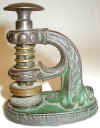 been engaged over two
years [since 1851] in the Manufacture and Sale of Percussion Presses & Seals.'"
Hall sold seal presses under the name "Evens' Percussion Press." Evens
sold them under the name "Evens' Patented Press," evidently even
before he was granted a patent.
The 1853 patent granted to Foster and Evens included a drawing of a seal press like the Evens
percussion seal press illustrated above. To the immediate right is a photo
of another Evens' Percussion Seal Press; engraved on the top of the knob is the
name of the maker, "C.F. Hall, Cincinnati, O." To the immediate left is
a photo (courtesy of Don Grampp) of the
label on an Evens' Lever No. 2 Seal Press. The label
shows the maker to be Platt Evens, Jr., Sole Proprietor, Cincinnati, O.
been engaged over two
years [since 1851] in the Manufacture and Sale of Percussion Presses & Seals.'"
Hall sold seal presses under the name "Evens' Percussion Press." Evens
sold them under the name "Evens' Patented Press," evidently even
before he was granted a patent.
The 1853 patent granted to Foster and Evens included a drawing of a seal press like the Evens
percussion seal press illustrated above. To the immediate right is a photo
of another Evens' Percussion Seal Press; engraved on the top of the knob is the
name of the maker, "C.F. Hall, Cincinnati, O." To the immediate left is
a photo (courtesy of Don Grampp) of the
label on an Evens' Lever No. 2 Seal Press. The label
shows the maker to be Platt Evens, Jr., Sole Proprietor, Cincinnati, O.
We have an 1851
advertisement for sealing and embossing presses, as well as copying, book and paper presses.
In 1864, the Confederate States of America purchased a great seal and press in
England. The seal and press were sent to America with Lt. Robert T.
Chapman, C.S.N. "After reaching Bermuda, Chapman apparently found the press
too cumbersome for running the blockade to America; and, according to some
sources, he left the press in Bermuda." (www.carolinadesignsonline.com)


Don Grampp has suggested that 19th century seal presses can be dated
approximately by the design of the underside. Seal presses made before
around 1860 seem to have bases with one or more flat surfaces. Beginning
around 1860, bases seem to have been similar to the earlier ones except that
they had one and later two small round holes into which molten metal was poured
to secure the bottom die. The photo on the left above shows a base of this
type with one pour hole. Later in the 19th century and in the 20th century,
bases seem to have had large indentations surrounding the pour holes, as in the
photo on the right above.
|
Model, Year Patented or Introduced, Maker |
Click Image to Enlarge |
| Jarrett's Improved
Embossing Press Exhibited 1851 (London) & 1855 (Paris) Griffith Jarrett London, UK |
|
| Seal Press Patented 1852 U.S. This large cast iron seal press has a human face on the left end above the die, which reads: Weyer & McKee, Madison, Ind., Wholesale Grocers, Iron & Commission Merchants. According to historical documents, Josiah S. Weyer and R. S. McKee did business in Madison as Weyer & McKee at least from 1848 through 1860. In 1861, President Lincoln gave preliminary approval for Weyer to serve as U.S. consul to Jerusalem, but Weyer was not appointed. |
 |
| Evens' Percussion Seal
Press (a.k.a. Evans' Percussion Seal Press) Introduced 1851 ~ Patented 1854 ~ Advertised 1860-63 Charles Francis Hall, Cincinnati, OH (see above) Platt Evens, Jr., Cincinnati, OH (see above) With a subtle difference in spelling, the Evans' Percussion Seal Press was manufactured by J. B. Knox & Lang, Worchester, MA (1860-63) |
 |
| Evens' Lever Seal Press and Evens' Lever No. 2 Seal Press Platt Evens, Jr. Cincinnati, OH |
Evens' Lever  Evens' Lever No. 2 |
| Fly Stamping Press Exhibited 1855 (Paris) Waterlow and Sons London, UK |
|
| Lever Stamping
Presses Exhibited 1855 (Paris) Waterlow and Sons London, UK |
|
| Seal Press Advertised 1855-60 Cutter, Tower & Co. Boston, MA |
 1855  1860 |
| Seal Press Advertised 1859 John Garrett New York, NY |
 |
| Seal Press Advertised 1860 M. B. Bigelow & Anson Hardy Boston, MA |
 |
| Lever Seal
Press Advertised 1860-63 J. B. Knox & Lang Worchester, MA |
 |
American Seal Press Patented 1865 ~ Advertised 1870, 1880 Power & Wallwork, New York, NY (1870) B. B. Hill, Springfield, MA (1880) U.S. Patent No. 47,821 awarded to Benjamin B. Hill. Advertised in 1870 with a patent lip attachment (included on Seaver's seal press, shown immediately below). "This is especially designed for embossing envelopes, it embosses the face of the envelope, leaving the back free from any mark." 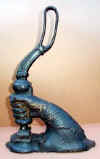 Chandler Seaver's American Seal Press, 1862-67 Seal press die reads: Chandler Seaver, Photographer, 27 Tremont Row, Boston. This machine was owned by Chandler Seaver, Jr. (1839-79), who had a photography studio at 27 Tremont Row during 1862-67, when he was 23 to 28 years old. The building he used at 27 Tremont Row, in downtown Boston, was demolished long ago. The building that replaced it was subsequently replaced by a large municipal government office building. The photograph below shows an advertising card for Seaver's studio at 27 Tremont Row.  Photographs to the right show abolitionists William Lloyd Garrison and Anna E. Dickinson. These photographs were taken by Seaver during 1862-67 while he was working at 27 Tremont Row, as were the photographs below showing shoes made in South Carolina and a family of five gathered around a table. The table was a studio prop that appears in other group photos taken by Seaver at 27 Tremont Row.  Earlier, in 1856, at the age of 17, Seaver was in a partnership, Seaver & Butler, located at 140 Washington St., Boston, MA.  Excerpt from 1856 Boston Almanac  In the early 1870s, a number of stereographic photos taken by Seaver in the southern US were published by Charles Pollock, Boston, MA, under the title The Southern Series. The photo above shows a man and eight boys in Jacksonville, FL, c. 1874. Seaver died at the age of 40 in 1879. |
|
| Seal Press Advertised 1861 C. Whitcomb & Co. Worcester, MA |
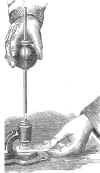 |
| Seal Press Advertised 1868 U.S. |
 |
| Lion Percussion
Embossing Press Design Patent No. 3,363 issued Feb. 9, 1869, to Robert B Carsley, Boston, MA Joseph H. Merriam, Merriam & Co. Boston, MA Joseph H. Merriam operated a die-sinking and medal business in Boston from 1850 to the 1860s. He moved to 18 Brattle Square, the address on the press, in 1857.  The die in the seal press to the right reads "Asahel Chase, East Saginaw, Mich." Chase lived from 1824 to 1886. According to research by Kelly Swartz of the Public Libraries of Saginaw, Chase was in East Saginaw during at least 1867-80 and was city clerk during at least 1870-73. According to other information, he was editor of the Evart Review in 1875, and he was buried near Evart. Evart is about 80 miles west of Saginaw. The die in an identical seal press reads "L. H. Ion, Real Estate and Insurance, Charlotte, Michigan." Charlotte is in south central Michigan, about 100 miles southwest of Saginaw. Launcelot H Ion was born in England in 1807. During
1843-48, he served as a justice of the peace, town clerk, and supervisor
in Grand Ledge, Michigan, 16 miles from Charlotte. In 1855, he was a
founder of the Eaton County Agricultural Society in Charlotte. The 1870
US Census reported that he was a Fire Insurance Agent in Charlotte. |
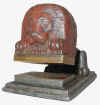 |
| Merriam's Patent
Embossing Press ~ Frog Merriam & Co. Boston, MA |
|
| Lion Seal Press Advertised 1870 Power and Wallwork New York, NY 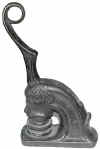 Many companies offered lion seal presses for many years and in a range of
sizes. In 1908 Tower Mfg. and Novelty Co. advertised lion head seal presses weighing 3.25 lb., 5.25 lb., 14.75 lb., and 36 lb.
The most common size is 5 lb - 7 lb. The photo to the left is
courtesy of Don Grampp. Many companies offered lion seal presses for many years and in a range of
sizes. In 1908 Tower Mfg. and Novelty Co. advertised lion head seal presses weighing 3.25 lb., 5.25 lb., 14.75 lb., and 36 lb.
The most common size is 5 lb - 7 lb. The photo to the left is
courtesy of Don Grampp.
|
 B.B. Hill, Springfield, MA, 1880 Patented 1883 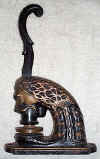 Patented 1904 |
| Buffalo
Embossing Press Patented 1871 ~ Advertised 1870s R. B. Carsley & Co., Chicago, IL The Buffalo Check Protecting Stamp Co., New York, NY The die in this machine reads: "L.C. Wilbur, Produce, Commission Merchant, Union Street, New Bedford, Mass." Research by Dolores Henry of the New Bedford Free Public Library found that Wilbur died in 1885 at the age of 57. His obituary stated "Mr. Lemuel C. Wilbur in early life went whaling, rising to the position of mate. For ten or twelve years he was an assistant marshal on the police and for a time kept a fruit store." R. B. Carsley & Co., Chicago, IL, "exhibited the Buffalo embossing press" in 1873. (Interstate Exposition Souvenir...Great Inter-State Exposition of 1873, Chicago, 1873, p. 189, no illustration.) Carsley was issued the 1869 design patent for the lion seal press marketed by Merriam & Co. (see above) Some examples of the Buffalo embossing press have the patent date July 25, 1871. We have not located this patent. However, the Buffalo embossing press appears in the illustration for Patent No. 152,329, which was awarded to Carsley in 1874. |
 |
| Seal Press Boston, MA The die reads "Trustees of the Consumptives' Home. Founded 1864. Incorporated 1871." Until the development of antibiotics well into the 20th century, there was no medical treatment for consumption, as tuberculosis was known in the 19th century. Dr. Charles Cullis (1833-92), a homeopathic physician, founded the Consumptives' Home in Boston in 1864 to care for destitute, incurable tuberculosis patients, who were refused care at public hospitals. Cullis was a prominent practitioner and advocate of faith healing. The healing power of prayer was an important tenet of the evangelical Holiness movement in the US between the Civil War and the early 20th century. By 1871, the Cullis Consumptives' Home was relocated to suburban Dorchester, MA, where Cullis also set up homes for patients with spinal diseases and for orphans. In Walpole, MA, he set up a home for cancer patients. These homes were financed by private contributions. In 1901, Dr. Duncan Macdougall conducted experiments at the Cullis Consumptives' Home. He weighed patients at the moment of death. He claimed to have found that there was a loss of weight at the moment of death for humans but not for dogs, which he interpreted as support for the existence of a human soul. (On MacDougall, see Mary Roach, Stiff: The Curious Lives of Human Cadavers, 2003.) According to one report, the Consumptives' Home closed around 1917. The Simmons College Library has annual reports from the Consumptives' Home as late as 1921. |
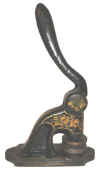 |
| Seal Press with Man with Ram's Horns |  |
| Buffalo Seal Press U.S. |
 |
| Eagle Seal Press U.S. |
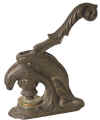 |
| Columbian Seal Press Patented 1883 R. J. Bennett, Maker Detroit, MI |
|
| Stationers' Stamping Press Advertised 1885 A. G. Mead Boston, MA "These presses are especially designed for the fine illuminated work now required. Have been in use by many of the principal Stationers for the past twelve years." |
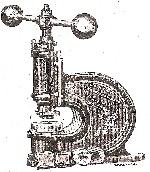 |
| Pocket Seal Press Advertised 1893 Schwaab Stamp & Seal Co. Milwaukee, WI; St. Paul, MN; Chicago, IL early 1900s These were marketed by companies in the early 1900s as well. |
 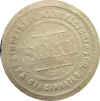 |
| Seal Press The die in this press is for a company that was founded in 1897. Its headquarters were in Scotland, and it had branches in several British Commonwealth countries. |
|
| Seal Press Patented 1900 Pearce F. Crowl Co. Baltimore, MD |
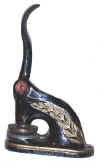 |
| Long Reach Seal Press Patented 1900 ~ Advertised 1910-c.1912 Emerson & Co. Boston, Mass. |
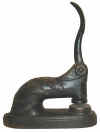 |
| Seal Press 1903 Sigwald Corp. Chicago, IL This seal press was identified by Don Grampp |
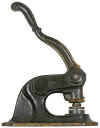 |
| Percussion Seal Press France |
 |
| Percussion Seal Press Advertised 1913 France |
 |
| Seal Press France The die in this press is for a notary. |
 |
| Rampant Lion Seal Press Germany |
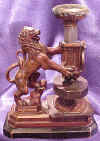 |
| Seal Press England |
|
| Seal Press Eziboss William Jones Clifton & Co. London, England William Jones Clifton & Co., die-sinkers and engravers, was founded in the first half of the 19th century. Trade publications dating at least from 1934 to 1946 identify the company as the manufacturer of Eziboss embossing presses. The company's cable address is "Eziboss." |
|
| Nymph Seal Press Eziboss William Jones Clifton & Co. London, England William Jones Clifton & Co., die-sinkers and engravers, was founded in the first half of the 19th century. Trade publications dating at least from 1934 to 1946 identify the company as the manufacturer of Eziboss embossing presses. The company's cable address is "Eziboss." |
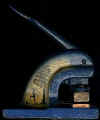 |

For photographs of additional seal presses, see Seal Press Information, including the Seal Press Collector Guide
Back to Top of this Page
Copyrighted 2000-2016.
All material on the Early Office Museum web site is copyrighted. All rights are reserved.
First, you must not plagiarize our material. Plagiarism
is the act of passing off as your own the words, photographs, or other work of
someone else. That is, not giving appropriate credit. Second, you must not violate our copyright, which means you may not use any images or text from the Early Office Museum web site in
publications, in direct mailing material, on web sites, in auction listings, or
anywhere else without written permission from the Curator. In some cases, images belong to someone else, and we cannot give
permission. If you make a
non-infringing use of information from this web site, please cite the Early
Office Museum and provide a link or our web address (www.officemuseum.com
or www.earlyofficemuseum.com).
If you believe that we have not given appropriate credit for your work or have violated your copyright, please email the curator so we can resolve the matter.
